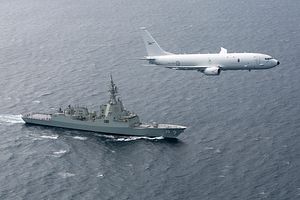The Royal Australian Air Force (RAAF) is dispatching one of its Boeing P-8A Poseidon maritime patrol aircraft to Kadena Air Base in Okinawa this week in support of the international effort to enforce United Nations Security Council resolutions on North Korea.
Australian Defense Minister Christopher Pyne said in a November 30 announcement that the deployment was part of Australia’s support of the international effort to enforce UN sanctions on North Korean vessels and stop their illegal activities in the East China Sea.
“This is part of Australia’s commitment to deter and disrupt illicit trade and sanctions evasion activities by North Korea and its associated networks,” Pyne said. “This deployment follows on from Defense’s previous contribution of a P-8A Poseidon maritime patrol aircraft in April, and two AP-3C Orion maritime patrol aircraft in September this year.”
The Boeing P-8A Poseidon, the military variant of Boeing’s Next-Generation 737-800 commercial aircraft, is one of the world’s most advanced maritime patrol aircraft in service. Australia currently operates four P-8A aircraft, with the remaining 11 aircraft slated to be delivered by March 2020 with full operating capability to be achieved by 2021.
“Australia continues to work with partners to maintain pressure on North Korea until it takes concrete, verifiable and irreversible steps to denuclearization,” Pyne added. “A stable and prosperous Indo-Pacific remains Australia’s priority.”
The United States and its allies including Australia Canada, Japan, and South Korea have been pressuring North Korea via sanctions to give up its nuclear weapons program.
Next to the aircraft, in September the Royal Australian Navy also dispatched the Adelaide-class guided-missile frigate HMAS Melbourne to patrol international waters off the Korean Peninsula to disrupt illicit trade and sanctions evasion activities.
“Despite the easing of tensions on the Korea Peninsula, Pyongyang continues with its nuclear weapons and ballistic weapons programs in defiance of … United Nations Security Council resolutions,” the Australian Defense Force chief of joint operations, Air Marshall Mel Hupfeld, told reporters in October.
“The occasional deployment of … maritime patrol aircraft and surface vessels to the region … adds weight to Australia’s ongoing economic and diplomatic pressure on North Korea and enhances the capacity of ongoing multinational enforcement efforts,” he said.
The Royal New Zealand Air Force also dispatched a P-3K2 Orion maritime patrol aircraft to Kadena Air Base in the fall to conduct maritime surveillance in East Asia waters. In July, the New Zealand government announced the purchase of four P-8As — one of the largest and most expensive defense procurement programs for the New Zealand Defense Force in recent years.

































